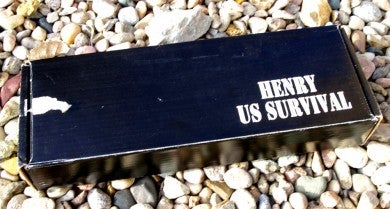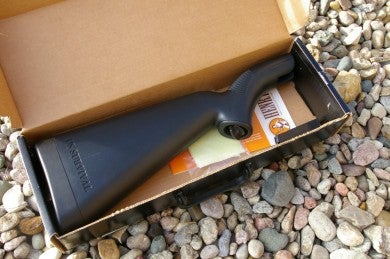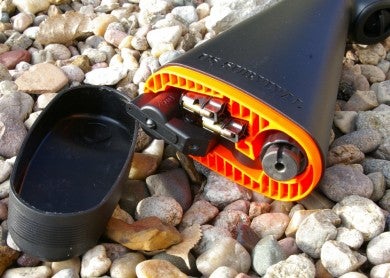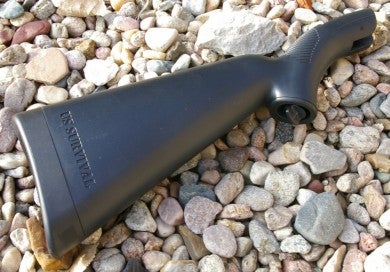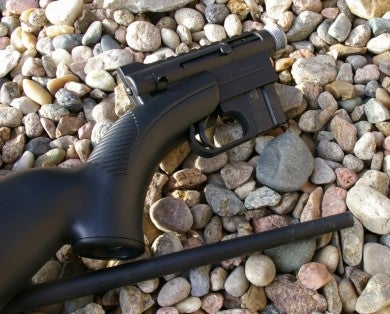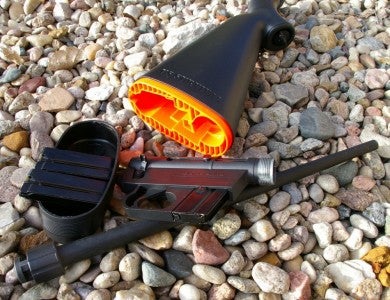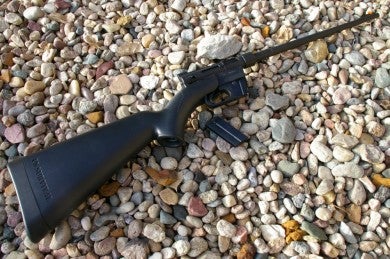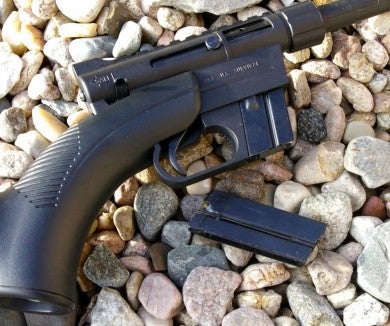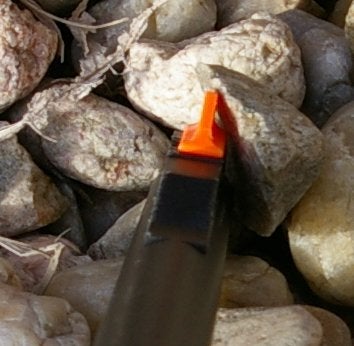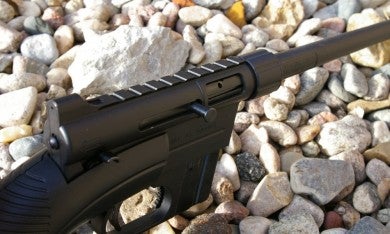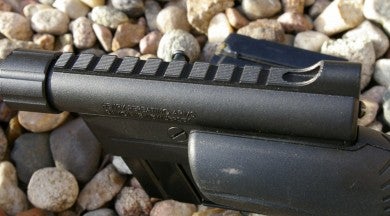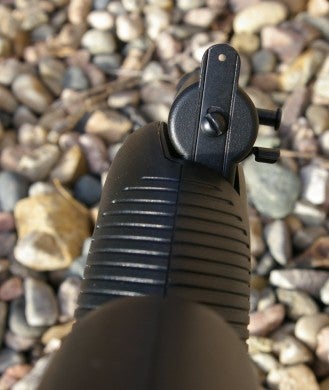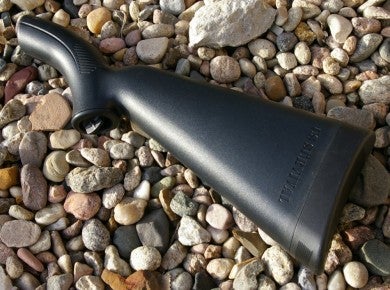A Brief History of the AR-7, and a Look at Henry Repeating’s US Survival AR-7
Major Pandemic 02.04.14
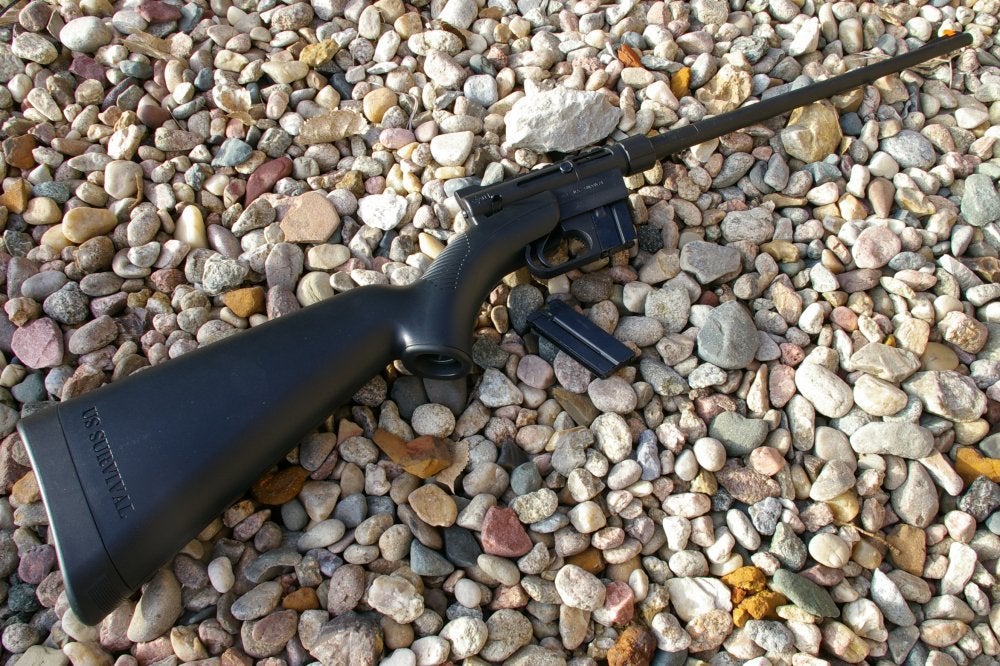
The AR-7 has to be one of the most resilient .22LR caliber platforms, and it was originally designed by famed AR-15 designer Eugene Stoner. As Armalite was being formed by Lockhead and Fairchild, their first actual developed and released firearm was the AR-5/MA-1. This was a bolt action, 4-shot, .22 Hornet survival rifle for the US military, and it was the immediate bolt action precursor the AR-7. It was an odd looking design where the barrel and action could be fully and compactly stored in the high tech stock, which would float, a handy feature if you were a pilot downed in water. The AR-5 and AR-7 are of the same design, with the exception of the semi-auto action and .22LR caliber changes.
When it was originally released, the massive plastic stock and aluminum receiver on the AR-5 was one of the most significant uses of plastics and aluminum on any gun. It was a groundbreaking innovation like none other. As Armalite submitted the design to the military, they realized through the development of the AR-5 that polymers, plastics, and light weight were the future of firearms. That spark of innovation started by a goofy looking little rifle lead to the first AR-10 prototypes a year later in 1955-1956, and then later the AR-15 series of rifles using new space age polymers and light weight alloys. Yes, the AR-5 and AR-7 spawned the AR-15 and the plastic gun revolution.
Meanwhile, the AR-5 was a hit, and civilians were screaming for a similar handy little take-down survival rifle. Armalite responded and developed the .22 caliber semi-automatic AR-7 design in 1959. The AR-7 was designed first and foremost as a packable survival rifle with features unlike any other rifle.
ArmaLite produced the AR-7 from 1959-1973, at which point Charter Arms purchased the rights and took over AR-7 manufacturing from 1973-1990. The 90’s are when the problems started for our little handy AR-7, as it was kicked around from manufacturer to manufacturer. Most consider the Charter Arms ownership of the AR-7 brand the beginning of the dark period. It was never an expensive or exceptionally reliable rifle, but it went from good quality at Armalite to cheaper manufacturing at Charter Arms and was riddled with reliability and quality issues.
To say Charter Arms damaged the AR-7 reputation was an understatement. The 1990-1997 Survival Arms ownership neither restored or improved the reputation or the quality of the AR-7. Survival Arms did attempt to focus on just the quintessential AR-7 rifle and nixed the whole AR-7 pistol idea Charter Arms had launched. Like the Henry Repeating Arms brand, the AR-7 was rescued by Mr. Anthony Imperato and his family owned firearms business. Henry reworked the design to increase reliability and further update the rifle with today’s manufacturing and high tech materials. The base of the original design still exists, and many older parts are still interchangeable, but the rifle has undergone a fairly significant barrel and stock upgrade under Henry Repeating’s stewardship.
The re-risen Henry Repeating Arms, now famous for the stunning, impeccably high quality Henry rifles everyone lusts after, have tackled the task of resurrecting the original idea and reliability of the inexpensive AR-7 survival rifle.
Why You Need a Henry AR-7
What’s the point of a $200, 2.5lb gun with a plastic stock, plastic steel lined barrel, and a checkered past? The AR-7 was purpose designed as a extremely light weight, compact, take down survival rifle, not as heirloom rifle, a brute of durability, a showpiece, or a target gun. If you purchase the gun as the lightest .22 you will ever handle, a fun hunting, plinking, and survival rifle to always be in your pack, you will be very pleased with the rifle, and it will perform that task admirably. If you think a $200 lightweight take-down gun will match the accuracy, durability, and any ammo reliability of your $700 Golden Boy or $400 Ruger 10/22, you are both missing the entire point of the rifle and a hopeless optimist.
Fit, Finish, and Feel
The AR-7’s fit and finish are perfectly suited for the intent of the rifle and a are substantial step up from the old Charter Arms and Survival Arms versions. The Teflon coating is nicely consistent throughout, and it would seem Henry took a little more care in re-creating the dies for the receiver. The newly updated Henry US Survival stock is also an improvement over old versions from a style, fit, and finish perspective. Today the new Henry U.S. Survival AR-7 feels much more solid and well made, considering its price and intent.
This rifle is a feathery 2.5lbs, and it is without a doubt the lightest .22LR rifle I have ever shot. Despite its durability and the chunky nature of the stock, the AR-7 feels delicate due to the weight. We are all used to swinging around 6-8lb rifles, and the AR-7 feels like a super-soaker. The balance is very good once the AR-7 is assembled, and the right sided offset on the stock to receiver mounting (which allows room in the stock for the barrel) looks odd but is ergonomically fine.
Features
The AR-7 has a new, more modern stock design that more securely holds the barrel, receiver, and magazines when disassembled, and now holds up to three loaded magazines, two in the stock plus one left in the receiver via the new safety orange stock insert. Parts still do rattle around in there slightly, but you also have room to stow a pocket knife and some fire starting extras under the stock pad/cover to dampen the rattle.
The AR-7 comes with two 8-shot magazines, but I would suggest picking up a few more from Henry.
The barrel is an ABS plastic, steel lined barrel coated in Teflon for complete protection from the elements. Eugene Stoner would be proud of this barrel innovation and its use on the AR-7. The aluminum receiver is also coated with Teflon, as well, in order to assure complete corrosion resistance. The barrel keys into the receiver and hand tightens firmly in place with the barrel nut.
The internals are made from stamped steel and, well, pretty much left that way. The trigger feel is regrettably long and not so great. This would be the primary reason why you would not want the AR-7 as your primary gun. After initial testing I did a simple trigger job on the AR-7 and the feel and accuracy improved greatly. I will cover how to do AR-7 Trigger job in a future article. What I do like is that the internals are so simple you could make replacement parts with a hacksaw and file if you had to — truly a survivalist rifle.
The sights carry on the rugged peep sights from the previous versions, and offer windage elevation via drifting the safety orange front sight and elevation via the rear peep sight. I recommend Lock-Tite’ing the sight in place zero’ed.
The rear peep sight can be flipped for a small or large peep aperture, but that would require re-zeroing and the large peep would be my preference anyway. The sights function great and are picked up naturally by the eye as you shoulder the gun. The receiver also features small .22 rails for scope or red-dot mounting.
Functioning and accuracy
Assembly is straightforward. Snap off the stock pad and remove the barrel, magazines, and receiver and snap the pad back on. Screw the receiver to the stock via the attached wing-nut on the stock, key the barrel into the receiver, and tighten the threaded locking barrel collar. Then you can slip in a magazine, charge the gun by pulling out on the bolt handle, and you are ready to shoot.
Everyone wants to know is whether Henry has finally made a reliable AR-7. The answer is that after break-in you will have the reliability you are hoping for.
Historically the previous AR-7 version have produced average accuracy with most groups in the 2” range at 25 yards, but the Henry U.S. Survival Ar-7 version seems to have improved those figures with 8-shot groups at 25 yards coming solidly in the 1.25 inch range. I could keep my 1.5” and 2.5” spinner targets going pretty consistently off hand, which is accuracy good enough for a survival rifle.
Final thoughts
I really love this little Henry U.S. Survival AR-7 rifle. It isn’t the fanciest, prettiest, or most accurate rifle, and it only really has an appetite for high quality hyper-velocity .22LR ammo. That said. it performs the task of a dependable, packable, and lightweight take-down rifle like no other rifle on the market. It’s also plenty durable, accurate, and totally reliable with the right ammo. It is so incredibly light that it will definitely become a permanent part of your hiking, trunk, camping, and bug out pack. For around $200 this is an inexpensive, unique, fun, and handy rifle to have around which is sure to provide you with a rifle when the need arises. Congratulations, Henry — I think you have broken the cycle of the AR-7 and restored the honor of the Stoner design with your updated version of Henry U.S. Survival AR-7 Survival Rifle.
U.S. Survival AR-7 Specs
- Model Number H002B
- Action Type Semi-automatic
- Caliber .22 LR
- Capacity 8 round magazine (comes with 2)
- Length 35″ assembled
- 16.5″ when stowed
- Weight 3.5 lbs.
- Stock ABS Plastic
- Sights Adjustable rear, blade front
- Finish Teflon coated receiver and coated steel barrel
- M.S.R.P.* $275.00
